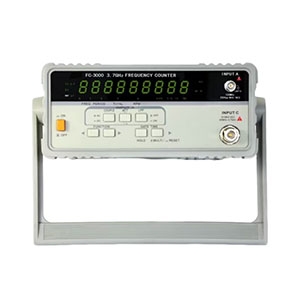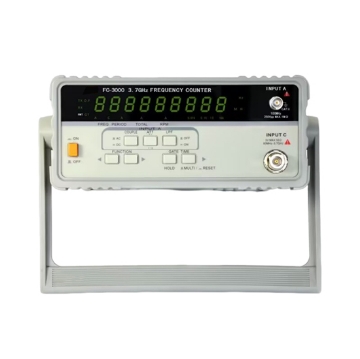Frequency Counters
100MHz-1GHz 8 Digit Digital Frequency Counter
100MHz-2.7GHz 8 Digit Digital Frequency Counter
1MHz-350MHz 10 Digit Frequency Counter
1MHz-350MHz 12 Digit Frequency Counter
80MHz-3.7GHz LCD Display Frequency Counter
A frequency counter, also known as a frequency meter, is an electronic measuring instrument specifically used to measure the frequency of the signal being measured.
Working Principle of Frequency Counter

The basic principle is to count the number of pulses of the measured signal per unit time and then display the frequency value in digital form. Specifically, the frequency counter is mainly composed of four parts : time base (T) circuit, input circuit, counting and display circuit and control circuit.
Time base circuit: The time base circuit provides a stable reference frequency signal for the frequency counter to compare and count with the measured signal. The frequency of the time base signal is usually much higher than the measured signal to ensure the accuracy and resolution of the measurement.
Input circuit : The input circuit is responsible for amplifying, shaping and filtering the measured signal so that the subsequent circuit can perform accurate counting. Counting and display circuit: The counting and display circuit performs counting and display operations based on the signals of the time base circuit and the input circuit. It usually displays the frequency value of the measured signal in digital form, and different display accuracy and resolution can be set as needed.
Control circuit: The control circuit is responsible for the workflow control of the entire frequency counter, including start, stop, calibration and other operations. At the same time, it can also communicate with other electronic devices to realize functions such as remote control and data transmission.
Frequency Counters Classification
Frequency counters can be divided into many types according to their measurement range, accuracy and functions. Here are some common classification methods :
Classification by measurement range: frequency counters can be divided into low-frequency frequency counters, radio frequency frequency counters and microwave frequency counters. Low-frequency frequency counters are mainly used to measure the frequency of audio signals and low-frequency electronic devices; radio frequency frequency counters are used to measure the frequency of radio signals and radio frequency equipment; microwave frequency counters can cover a higher frequency range and are suitable for microwave communications and radars.
Classification by accuracy: frequency counters can be divided into ordinary precision frequency counters, high precision frequency counters and ultra-high precision frequency counters. Ordinary precision frequency counters are suitable for general measurement needs; high precision frequency counters have higher measurement accuracy and resolution, and are suitable for precision measurement and scientific research. Ultra-high precision frequency counters can achieve higher accuracy and stability, and are important tools in the field of measurement and calibration.
Classification by function: In addition to the basic frequency measurement function, some frequency counters also have other functions, such as period measurement, phase measurement, duty cycle measurement, counting function, etc. The addition of these functions makes the frequency counter more widely used in the fields of electronic measurement and communication.
Functional Characteristics of Frequency Counter
- High-precision measurement: The frequency counter uses advanced counting technology and signal processing algorithms to achieve high-precision frequency measurement. The measurement accuracy of some high-precision frequency counters can reach multiple decimal places.
- Wideband measurement: The frequency counter can cover a wide frequency range and can measure from audio signals to microwave signals. This makes the frequency counter widely used in many fields.
- Multiple measurement functions: In addition to basic frequency measurement, the frequency counter can also perform multiple measurement functions such as period measurement, phase measurement, duty cycle measurement, etc. The addition of these functions makes the frequency counter more comprehensive and practical in the field of electronic measurement.
- Data storage and transmission: Frequency counters usually have data storage and transmission functions, which can save measurement results in internal memory or transmit data with external devices through interfaces. This makes it easy for users to record and share measurement results .
Application of Frequency Counters
Frequency counters are widely used in many fields. The following are some typical application scenarios.
Wireless communication field: In wireless communication systems, frequency counters are used to measure the frequency and stability of wireless signals to ensure communication quality and system performance.
Electronic measurement field: In electronic measurement, frequency counters are used to measure the frequency response and performance paracounters of various electronic devices, such as amplifiers, filters, oscillators, etc.
Scientific research and metrology: In the fields of scientific research and metrology, frequency counters are used for high-precision measurement and calibration work, such as calibration and testing of atomic clocks, spectrocounters and other equipment.
Industrial production field: In industrial production, frequency counters are used to monitor and control the operating status and performance paracounters of production equipment, such as motor speed, sensor output, etc.
Through SISCO 's introduction, users can have a deeper understanding of the technical characteristics and applications of frequency counters, providing a useful reference for research and application in related fields. Contact SISCO if you have any questions about frequency counter, we will answer you as soon as possible!






